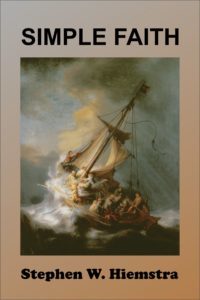Stephen W. Hiemstra's Blog, page 210
April 8, 2018
Prayer for Church Workers
 By Stephen W. Hiemstra
By Stephen W. Hiemstra
Almighty Father,
Bless the workers in your church with your special presence during this spring season.
Grant them strength to get their work done, grace to extend your blessings to those they serve, and the peace that passes all understanding.
Give them more hours in every day and quiet time to listen for your voice that their work will reflect your glory and more people will come to call you father.
In the power of your Holy Spirit, revive your church; revive us.
In Jesus’ tender name, Amen.
Prayer for Church Workers
Also see:
Giving Thanks
A Place for Authoritative Prayer
Other ways to engage online:
Author site: http://www.StephenWHiemstra.net, Publisher site: http://www.T2Pneuma.com.
Newsletter at: http://bit.ly/Holy_Week_2018
The post Prayer for Church Workers appeared first on T2Pneuma.net.
April 6, 2018
Creation and Trinity
 By Stephen W. Hiemstra
By Stephen W. Hiemstra
The Bible starts telling us that: “In the beginning, God created the heavens and the earth.” (Gen 1:1) What do these simple words tell us about God?
In the Beginning
The phrase—in the beginning—tells us that God is eternal. If creation has a beginning, then it must also have an end. This implies that creation is not eternal, but the God who created it must be. If our eternal God created time, both the beginning and the end, then everything God created belongs to God. Just as the potter is master over the pottery he makes, God is sovereign over creation (Jer 18:4-6). God did not win creation in an arm-wrestling match or buy it online or find it on the street, he created it—God is a worker (Whelchel 2012, 7).
Transcendence
God eternal existence suggests that as mortal beings we cannot approach God without his assistance, an immediate consequence of God’s transcendence. The story of the Tower of Babel in Genesis 11:1-9 makes this point in a physical sense, but it also stands as a metaphor for philosophical towers that we might attempt to build, such as the Enlightenment Project.
Sovereignty
God’s sovereignty is reinforced in the second half of the sentence when it says: God created the heavens and the earth. Here heaven and earth form a poetic construction called a merism. A merism is a literary device that can be compared to defining a line segment by referring to its end points. The expression—heaven and earth—therefore means that God created everything.[1] Because he created everything, he is sovereign over creation; and sovereignty implies ownership.[2]
Holy
So, from the first sentence in the Bible we know that God is eternal and he is sovereign. We also know that he is holy. Why? Are heaven and earth equal? No. Heaven is God’s residence. From the story of Moses’ encounter with God in the burning bush (Exod 3:5), we learn that any place where God is becomes holy in the sense of being set apart or sacred. Because God resides in heaven, it must be holy. Earth is not. Still, God created both and is sovereign over both (Rev 4:11).
Genesis paints two other important pictures of God.
Holy Spirit
The first picture arises in Genesis 1:2; here the breath, or spirit of God, is pictured like a bird hovering over the waters.[3] Hovering requires time and effort suggesting ongoing participation in and care for creation. The Bible speaks exhaustively about God providing for us—God’s provision. Breath translates as Holy Spirit in the original languages of the Bible—both Hebrew (Old Testament) and Greek (New Testament).[4]
Immanence
The second picture appears in Genesis 2, which retells the story of creation in more personal terms. As a potter works with clay (Isa 64:8), God forms Adam and puts him in a garden. Then, he talks to Adam and directs him to give the animals names. And when Adam gets lonely, God creates Eve from Adam’s rib or side—a place close to his heart.
Summary
Genesis 1 and 2, accordingly, paint three pictures of God: 1. God as a mighty creator; 2. God who meticulously attends to his creation; and 3. God who walks with us like a friend. While the Trinity is not fully articulated in scripture until the New Testament, God’s self-disclosure as the Trinity appears from the beginning (Chan 1998, 41).
The Lord’s Prayer casts a new perspective on Genesis 1:1when Jesus says: “Your kingdom come, your will be done, on earth as it is in heaven.” (Matt 6:10) Because we are created in God’s image, we want our home to modeled after God’s.
References
Dyck, Drew Nathan. 2014. Yawning at Tigers: You Can’t Tame God, So Stop Trying. Nashville: Thomas Nelson.
Whelchel, Hugh. 2012. How Then Should We Work? Rediscovering the Biblical Doctrine of Work. Bloomington, IN: WestBow Press.

[1] Heaven and earth can also be interpreted as proxies for God’s attributes of transcendence and immanence (Jer 23:23-24; Dyck 2014, 99).
[2] God’s eternal nature is also defined with a merism: “I am the Alpha and the Omega,” says the Lord God, “who is and who was and who is to come, the Almighty.” (Rev 1:8)
[3] This bird (avian) image appears again in the baptismal accounts of Jesus. For example, in Matthew 3:16 we read: “And when Jesus was baptized, immediately he went up from the water, and behold, the heavens were opened to him, and he saw the Spirit of God descending like a dove and coming to rest on him.”
[4] Breath itself is necessary for life—part of God’s provision.
Creation and Trinity
Also see:
A Roadmap of Simple Faith
Christian Spirituality
Looking Back
A Place for Authoritative Prayer
Other ways to engage online:
Author site: http://www.StephenWHiemstra.net, Publisher site: http://www.T2Pneuma.com.
Newsletter: http://bit.ly/Holy_Week_2018
The post Creation and Trinity appeared first on T2Pneuma.net.
April 3, 2018
Bly Writes to Sell, Part 1
 Robert W. Bly. 2005. The Copywriter’s Handbook: A Step-by-Step Guide to Writing Copy that Sells. New York: St. Martin’s Griffin. (Goto part 2)
Robert W. Bly. 2005. The Copywriter’s Handbook: A Step-by-Step Guide to Writing Copy that Sells. New York: St. Martin’s Griffin. (Goto part 2)
Review by Stephen W. Hiemstra
At the heart of the Gospel is a tough sell: give up your sinful desires and surrender your life to God. In my work at T2Pneuma Publishers LLC, I summarize the Gospel with this catch phrase: Hear the words; Follow the steps; Experience the joy! Only the Holy Spirit can close the deal, but the pitch must be made. The trouble is that most Christians, myself included, are terrible at sales.
Introduction
In his book, The Copywriter’s Handbook, Robert W. Bly sets out with a clear objective:
“This book is written to give you guidelines and advice that can teach you to write effective copy—that is, copy that gets attention, gets its message across, and convinces the customer to buy the product.” (xv)
He defines copywriters as “salespeople whose job is to convince people to buy products” (xvi) and should not be confused with the process of registering a copyright for a book with the Library of Congress.
Bly’s Writing Philosophy
For those you who associate copywriting with those catchy ads placed during the Super Bowl, Bly’s focus on ads that communicate and sell may come as a surprise. But ask yourself a simple question, do you remember what products those Super Bowl ads were intending to sell? If not, then the ads may have caught your attention, but for the wrong reasons. Because advertising is expensive, it is important to focus on the informational and sales objectives in creating an ad.
Christians may get squeamish at this point and respond, as I have, that they are not salespeople. Maybe. But why does Charlie Brown feel compelled to ask: “What is the true meaning of Christmas?” If the message is unclear; it will not be heard. Because with the Gospel the stakes are high, we need to communicate clearly.
Organization
Bly is a professional copywriter who specializes in B2B, high tech, and direct-response advertising and is a prolific author. Outside of front matter and numerous appendices, he writes in fifteen chapters:
An Introduction to Copywriting
Writing to Get Attention: The Headline
Writing to Communicate
Writing to Sell
Getting Ready to Write
Writing Print Advertisements
Writing Direct Mail
Writing Brochures, Catalogs, and Other Sales Materials
Writing Public Relations Materials
Writing Commercials and Multimedia Presentations
Writing for the Web
Writing E-Mail Marketing
How to Get a Job as a Copywriter
How to Hire and Work with Copywriters
Graphic Design for Copywriters (xii)
While I started out thinking that I only really had an interest in the first couple chapters here, as I read on I discovered that Bly addressed a much wider set of my business writing activities than I had envisioned. Other than the chapters on working as and hiring copywriters, each of the chapters offered helpful advice on diverse aspects of my publishing business—much more than any of the numerous writing books that I have read—from issuing press releases to writing a newsletter.
Example
For example, Bly reports that copywriters write two types of emails: the “solo email” and the “e-zine” The solo email is written to a distribution list promoting a single product (think direct marketing campaign, the online equivalent of junk mail) while the e-zine is an online newsletter (286). While this distinction may seem obvious, most independent writers focus exclusively on their personal newsletter, while a business-driven minority use product giveaways to launch automated email promotion campaigns. Bly is the first author that I have read who discusses the quality points of both alternatives.
Assessment
In part one of this review, I have given an overview of Robert W. Bly’s The Copywriter’s Handbook. In part two, I will look in more depth at Bly’s approach to writing ads. For those interested in learning about how to write advertisements that sell, Bly’s book provides a clear and complete guide.
B2B is short for business to business. http://www.Bly.com.
Bly Writes to Sell, Part 1
Also see:
Scott Writes Pro Email Newsletters
Books, Films, and Ministry
Other ways to engage online:
Author site: http://www.StephenWHiemstra.net, Publisher site: http://www.T2Pneuma.com.
Newsletter at: http://bit.ly/Holy_Week_2018
The post Bly Writes to Sell, Part 1 appeared first on T2Pneuma.net.
April 2, 2018
Monday Monologue, Sermon, April 2, 2018 (Podcast)
 Stephen W. Hiemstra, 2017
Stephen W. Hiemstra, 2017By Stephen W. Hiemstra
In today’s podcast, I share a sermon, Slave of Christ.
To listen, click on the link below.
After listening, please click here to take a brief listener survey (10 questions).
http://t2pneuma.net/wp-content/uploads/2018/03/Monday_Monologue_2_20180323.mp3
Monday Monologue, Sermon, April 2, 2018 (Podcast)
Also see:
Monday Monologue On March 26, 2018
Other ways to engage online:
Author site: http://www.StephenWHiemstra.net, Publisher site: http://www.T2Pneuma.com.
Newsletter: http://bit.ly/Holy_Week_2018
The post Monday Monologue, Sermon, April 2, 2018 (Podcast) appeared first on T2Pneuma.net.
April 1, 2018
Mark 16: Easter 2
 By Stephen W. Hiemstra
By Stephen W. Hiemstra
“And he said to them, Do not be alarmed. You seek Jesus of Nazareth, who was crucified.
He has risen; he is not here. See the place where they laid him” (Mark 16:6 ESV).
One of the most vivid memories I have as a young person was the experience of an Easter sunrise. Easter is mysterious, earth-shattering news. How could I sleep through it?
Funeral
At my grandfather’s funeral, I was given a head of wheat which hangs now in my kitchen. The wheat reminds me of Jesus’ saying: “Truly, truly, I say to you, unless a grain of wheat falls into the earth and dies, it remains alone; but if it dies, it bears much fruit” (John 12:24 ESV).
Resurrection Reminders
The mystery of resurrection is everywhere in nature. Sunrise is the resurrection of the day. Springtime is the resurrection of the seasons. The metamorphosis from caterpillar to cocoon to adult butterfly is a beautiful, dramatic resurrection. The Apostle Paul writes: “all of creation groans in anticipation of our redemption” (Romans 8:19-23).
Messianic Prophecies
Prophesies of Jesus’ resurrection start early in scripture. Systematic theologians see salvation history as creation, fall, and redemption. Because sin is the cause of death, eternal life requires forgiveness of sin which is brought about in Christ’s resurrection. This transition is prophesied in Genesis: “I will put enmity between you and the woman, and between your offspring and her offspring; he shall bruise your head, and you shall bruise his heel” (Gen 3:15 ESV).
Other theologians see resurrection arising out of righteous suffering. The prophet Job writes not only of Christ, but his own resurrection: “For I know that my Redeemer lives, and at the last he will stand upon the earth. And after my skin has been thus destroyed, yet in my flesh I shall see God, whom I shall see for myself, and my eyes shall behold, and not another” (Job 19:25-27 ESV). At the birth of the church on Pentecost (Acts 2:27), the Apostle Peter sees resurrection prophesied by King David: “For you will not abandon my soul to Sheol, or let your holy one see corruption” (Psalm 16:10).
When asked to produce a sign Jesus himself spoke of the sign of Jonah (Luke 11:29-32). In the belly of the whale Jonah prayed: “I called out to the LORD, out of my distress, and he answered me; out of the belly of Sheol I cried, and you heard my voice” (Jonah 2:2 ESV). And the whale spit him out on dry land, another resurrection story.
Old Testament Resurrections Accounts
Resurrection did not start with Jesus. Some see the story of the binding of Isaac as a resurrection account and a prophecy of the cross (Genesis 22:1-18). The prophet Elisha raises the Shunammite’s son from the dead (2 Kings 4:32-37). In the valley of bones, Ezekiel prophesied about resurrection of the Nation of Israel (Ezekiel 37:3-6). The exodus of the nation of Israel from Egypt and the return of the exiles from Babylon are both resurrection accounts where a dead nation rises to new life.
New Testament Resurrection Accounts
In the gospels, Jesus himself performed several resurrections. He raised Jairus’s daughter from the dead (Mark 5:22-43). He raised the widow’s son (Luke 7:12-17). Most remarkably, after lying four days in the tomb he raised Lazarus from death (John 11:1-45). Like other resurrections, Jesus’ healings and exorcisms brought hope where there was none.
Some scholars believe that John Mark’s gospel recorded Apostle Peter’s testimony while he was in Rome during AD 41-54. Mark later traveled with Paul. Mark’s role was to teach about the life of Jesus. Later, Luke may have assumed this role in Paul’s missionary team.
Mark’s Unusual Ending
Interestingly, Mark did no see the gospel ending with Jesus. Neither did Luke whose gospel was followed by the Book of Acts. Mark’s gospel starts with: “The beginning of the gospel of Jesus Christ, the Son of God” (Mark 1:1 ESV). Scholars believe that Mark’s gospel ends with the woman going out from the tomb to relay the angel’s message: “But go, tell his disciples and Peter that he is going before you to Galilee” (Mark 16:7 ESV). Likewise, our part in salvation history is to pass on the story. As the hymnist Katherine Hankey (1834-1911) writes: “I love to tell the story, of unseen things above, of Jesus and his glory, of Jesus and his love…” [2]
Christian Hope
Christian hope starts with the resurrection: we know that death is not the end of life’s story. And because we know the rest of the story, we can invest in life and live each day with boldness and joy.
Did Abraham believe God would raise Isaac from the dead? Why did the angel have to tell Abraham twice?
[2] www.hymnsite.com/lyrics/umh156.sht
Mark 16: Easter 2
Also see:
A Roadmap of Simple Faith
Christian Spirituality
Looking Back
A Place for Authoritative Prayer
Other ways to engage online:
Author site: http://www.StephenWHiemstra.net, Publisher site: http://www.T2Pneuma.com.
Newsletter: http://bit.ly/Holy_Week_2018
The post Mark 16: Easter 2 appeared first on T2Pneuma.net.
March 31, 2018
Mark 15: Holy Saturday 2
 By Stephen W. Hiemstra
By Stephen W. Hiemstra
“And Joseph bought a linen shroud, and taking him down, wrapped him in the linen shroud
and laid him in a tomb that had been cut out of the rock.
And he rolled a stone against the entrance of the tomb.” (Mark 15:46 ESV)
Jesus is buried on the Day of Preparation which ends at sundown when the Jewish Sabbath begins. This detail in Mark’s Gospel is important because burial was forbidden on the Sabbath and executed criminals could not hang overnight (Deut 21:23). The Gospels mention nothing taking place on the Sabbath while Jesus lay in the tomb and the narrative resumes on the following day. In other words, Jesus rested in the tomb over the Sabbath. Holy Saturday was a day of mourning and grief.
A Grieving Holiday
Grief is more than crying. In Jesus’ Beatitudes, Matthew records: “Honored are those who mourn, for they shall be comforted.” (Matt 5:4) Luke records: “Honored are you who weep now, for you shall laugh.” (Luke 6:21) Both accounts of this Beatitude are written in the form of a lament which has two parts. In the first part, one empties the heart of all grief and pain and anxiety in prayer to God; in the second part, having been emptied the heart turns to God in praise. In the lament, when we grieve, we make room in our hearts for God.
The Theology of Lament
The most famous lament in the Bible is cited by the Gospel of Mark as Jesus’ last words: “My god, my god, why have you forsaken me?” (Mark 15:34) These words come from Psalm 22 verse one which turns to God in verse 19: “But You, O LORD, be not far off; O You my help, hasten to my assistance.” At a time when much of scripture was memorized, rabbis would cite the first part of a passage knowing that the audience would fill in the missing part. Knowing this tradition, Jesus could cite the first verse in Psalm 22 knowing that people hearing him would know the Psalm and how it ended.
Jesus gave us a template for dealing with grief the night before during his prayer in Gethsemane. Mark records that Jesus’ prayed three times: “Abba! Father! All things are possible for You; remove this cup from Me; yet not what I will, but what You will.” (Mark 14:36). Jesus is aware that he stands before the cross and does not want to die; still, he yields to God’s will. Each time we face pain and grief we are faced with a decision: do we turn to God or do we turn into our grief? Our identity is crafted from a lifetime of such decisions.
Joseph of Arimathea
The story of Joseph of Arimathea is instructive. Mark records: “Joseph of Arimathea, a respected member of the council, who was also himself looking for the kingdom of God, took courage and went to Pilate and asked for the body of Jesus.” (Mark 15:43) Asking for the body of a man just crucified for sedition took guts. Yet, with no expectation of resurrection, on a day when Jesus’ inner circle was in hiding and in fear, Joseph “took courage” and asked Pilate for the body of Jesus. Then, he buried him in his own grave [4].
Holy Saturday Reveals our Theology
Holy Saturday is a time to reflect on Christ’s crucifixion. Are we among those happy to see Jesus in the tomb or are we looking forward to the kingdom of God like Joseph of Arimathea?
Burial is work, hence forbidden on the Sabbath (e.g. Deut 5:12-15).
Also: Matthew 27:46. The direct citation of an Aramaic expression—“Eli, eli, lama sabachthani?” in both the Mark and Matthew accounts makes it more likely that these are the actual words of Jesus. This is because the most important expressions in the Bible are cited directly rather than translated or, in this case, the actual words are both cited and translated.
Jesus does exactly that in Matthew 21:16 citing Psalm 8:2.
[4] What a picture of substitutionary atonement—Jesus was buried in my grave so that I do not have to be.
Mark 15: Holy Saturday 2
Also see:
A Roadmap of Simple Faith
Christian Spirituality
Looking Back
A Place for Authoritative Prayer
Other ways to engage online:
Author site: http://www.StephenWHiemstra.net, Publisher site: http://www.T2Pneuma.com.
Newsletter: http://bit.ly/Holy_Week_2018
The post Mark 15: Holy Saturday 2 appeared first on T2Pneuma.net.
March 30, 2018
Mark 15: Good Friday 2
 The Crucifixion
The CrucifixionBy Stephen W. Hiemstra
“And when the centurion, who stood facing him, saw that in this way he breathed his last, he said,
Truly this man was the Son of God!” (Mark 15:39 ESV)
Second Trial
Pontius Pilate gets right to the point: “Are you the King of the Jews?” Jesus answers with two words–σὺ λέγεις—which means: you say (Mark 15:2). The chief priests accuse him of many things. Pilate asks Jesus a second question: “Have you no answer to make?” (Mark 15:4) Jesus does not respond (Isaiah 53:7). Pilate is amazed.
First Trial
The night before, the high priest asked Jesus if he is the Messiah (Christ). Jesus responded using the words God from Exodus 3:14 saying: “I am”. Then, in case anyone misunderstood him, he paraphrased the messianic prophecy in Daniel 7:13: “you will see the Son of Man seated at the right hand of Power, and coming with the clouds of heaven” (Mark 14:62 ESV). The high priest accordingly accused Jesus of blasphemy which is punishable by stoning under Jewish law (Leviticus 24:16). But since Rome reserved the right to decide all cases of capital punishment, the chief priests accused Jesus of the political crime of sedition—treason against Rome. This is why Pilate asked Jesus: “Are you the King of the Jews?” (Mark 15:2)
What Kind of Messiah?
Realizing that Jesus is innocent of the charge of sedition, like a good politician Pilate begins working the crowd. In offering to release a prisoner named Barabbas, who was guilty of both sedition and murder (Mark 15:7), Pilate is effectively asking the crowd what kind of Messiah they prefer. The crowd asked for Barabbas who was known to be a Jewish nationalist—in other words, the crowd prefers a kingly Messiah.
Messiah means anointed one in Hebrew which translates as Christ in Greek. Three types of roles are anointed: prophets, priests, and kings. In his earthly ministry, Jesus embodied the first two roles (prophet and priest), but the crowd wanted a king—someone to drive the Romans out—as we saw earlier in Mark 11:10.
So Pilate gave them what they wanted (Romans 1:24-25), washed his hands of the decision, and sent Jesus to the cross.
Mark 15: Good Friday 2
Also see:
A Roadmap of Simple Faith
Christian Spirituality
Looking Back
A Place for Authoritative Prayer
Other ways to engage online:
Author site: http://www.StephenWHiemstra.net, Publisher site: http://www.T2Pneuma.com.
Newsletter: http://bit.ly/Holy_Week_2018
The post Mark 15: Good Friday 2 appeared first on T2Pneuma.net.
March 29, 2018
Mark 14: Maundy Thursday 2
 Foot washing
Foot washingBy Stephen W. Hiemstra
“Three times a year all your males shall appear before the LORD your God at the place that he will choose: at the Feast of Unleavened Bread (הַמַּצּ֛וֹת), at the Feast of Weeks (הַשָּׁבֻע֖וֹת), and at the Feast of Booths (הַסֻּכּ֑וֹת; Deuteronomy 16:16 ESV).
Holy Week as we know it is often celebrated at the same time as the Jewish Feast of Unleavened Bread (Festival of Matzos) often called Passover. Dates differ because of differences in the calendar rules. In Jesus’ time, Passover was one of three festivals that required the faithful to travel to Jerusalem. The other festival familiar to Christians is the Feast of Weeks commonly known as Pentecost. The Feast of Booths is a harvest festival in the fall.
Passover Backstory
Passover commemorates the release of the Jewish people from slavery in Egypt. God instructed Moses to tell the Israelite to sacrifice a lamb and place the blood of the lamb over their door-posts so that the angel of death would pass them by. On the night of the Passover, the angel of death struck down the first born of Egypt and passed over the Israelite households. Pharaoh reacted immediately by expelling the Israelite slaves. They left so quickly that there was not time to bake bread for the journey. Instead, they prepared bread without letting the dough rise—unleavened bread (Exodus 12). Mark 14:12-26 describes how Jesus and his disciples celebrated the Passover meal in Jerusalem now remembered as the Last Super.
Covered by the Blood
The Last Super is important to Christians because it introduces the new covenant in Christ. The word, covenant, found in v. 24 appears nowhere else in Mark’s Gospel and alludes to the covenant meal that Moses and the Elders of Israel shared with God on Mount Sinai (Exodus 24:9-11). The grim symbolism of the wine as the blood of Christ is an allusion to the blood of the Passover lamb (Exodus 12:7) which alerted the angel of death to pass over households displaying the blood. In this sense, as Christians we are (like the door posts) covered by the blood of Christ. By Jesus’ blood our sins are forgiven and we are passed over (Hebrews 9:11-28).
Where Does Maundy Thursday Come From?
Where does the name, Maundy Thursday, come from? One theory is that it is Middle English for the Latin word, Mandatum, which means command. According to some traditions, Maundy Thursday focuses on Jesus’ lesson on servant leadership: “If I then, your Lord and Teacher, have washed your feet, you also ought to wash one another’s feet” (John 13:14 ESV).
Mark 14: Maundy Thursday
Also see:
A Roadmap of Simple Faith
Christian Spirituality
Looking Back
A Place for Authoritative Prayer
Other ways to engage online:
Author site: http://www.StephenWHiemstra.net, Publisher site: http://www.T2Pneuma.com.
Newsletter: http://bit.ly/Holy_Week_2018
The post Mark 14: Maundy Thursday 2 appeared first on T2Pneuma.net.
March 27, 2018
Heifetz and Linsky Lead from Technical to Adaptive Change
 Art by Stephen W. Hiemstra
Art by Stephen W. HiemstraRonald A. Heifetz and Marty Linsky. 2002. Leadership on the Line: Staying Alive through the Dangers of Leading. Boston: Harvard Business School Press.
Review by Stephen W. Hiemstra
The March for Life in Washington on March 24 is a call for action to prevent gun violence. While this march represents a felt need, it has not proceeded to the next step in defining the problem. There are, of course, calls for new legislation to reduce gun availability, but past efforts at legislation have failed to alleviate the problem. What then should be done?
Introduction
In their book, Leadership on the Line: Staying Alive through the Dangers of Leading, Ronald Heifetz and Marty Linsky assert:
we believe you can “walk the line,” [citing Johnny Cash] step forward, make a difference, take the heat, and survive to delight in the fruits of your labor.
In fact, they see leadership providing meaning to life itself in spite of obvious dangers and discouragements (3, 11-12).
Technical versus Adaptive Change
A key insight in Heifetz and Linsky’s work is to distinguish technical from adaptive challenges. In a technical change, authorities apply current know-how to solve a problem while in an adaptive change people with the problem must learn new ways to solve the problem (14). A technical change typically requires nothing more than additional budget (or a change in legislation, a kind of symbolic action) while an adaptive change requires an entirely new approach—we must change, not the budget or any other easy fix (18).
Technical Change
Heifetz and Linsky cite the example of a car that breaks down. If your car breaks down, then you can take it to a mechanic and get it fixed. However, if your car breaks down because of how the family drives it, then the problem is likely to come up over and over until the family changes how the car is driven. The mechanic can fix the first problem (car breaks down), but only the family itself can fix the second problem (repeated break downs; 19). The rub arises because: Habits, values, and attitudes, even dysfunctional ones, are part of one’s identity. To change the way people see and do things is to challenge how they define themselves (27). As a consequence, adaptive problems are inherently more difficult and costly to deal with.
Importance of Adaptive Change
Because current leaders were promoted to bring organizations to the point they find themselves in today, part of the challenge of adaptive change arises in dealing with dealing with those with a vested interest in the way things are. Heifetz and Linsky observe that resistance to change often comes from unexpected places and people. They see the 4 principal dangers to leaders being marginalization, diversion, attack, and seduction (31). Marginalization can take the form of tokenism, neglect, or professional pigeon-holing (32-37). Diversion results in a loss of focus—taking on too many issues or being promoted off-line (38-40). Attacks may focus on your ideas, character, competence, family, or physical existence (42) [2]. Seduction arises as constituents for change insist on taking the issue too far and the leader then fails chasing the dream rather than accomplishing real, doable change (45-48).
Fog of War
Emotions rage and helpful information is often absent during periods of change. In the military, this is called the fog of war. Heifetz and Linsky accordingly observe the need to maintain the capacity for reflection—to observe more clearly what is really going on (52). During movies of the 1930s and 1940s, during dance or dinner party scenes characters frequently retreated to a balcony to talk (or have a smoke) where they figured out their strategies. On the balcony, Heifetz and Linsky see 4 useful activities:
Distinguish technical from adaptive changes;
Find out where people are at;
Listen to the song beneath the words (do not accept things at face value); and/or
Read the behavior of authority figures for clues (55).
A Christian might substitute the expression—Sabbath rest—for balcony here as we lead our families through the stresses and struggles of life.
Organization
Heifetz and Linsky’s Leadership on the Line is written in 11 chapters divided into 3 parts: The Challenge, the Response, and Body and Soul. The chapters are:
The Heart of Danger;
The Faces of Danger;
Get on the Balcony;
Think Politically;
Orchestrate the Conflict;
Give the Work Back;
Hold Steady;
Manage Your Hungers;
Anchor Yourself;
What’s On the Line? And
Sacred Heart (vii).
These chapters include an introduction and notes, an index, and write-up about the authors in the pages that follow.
Example of Adaptive Change Challenge
Heifetz and Linsky’s distinction between technical and adaptive changes is most useful. I cannot tell you how many meetings that I attended in the government where a focus on “low hanging fruit”—technical changes which really did not address the issue but gave managers an opportunity to pretend to do something—pushed aside attempts at adaptive change.
Conversion as Adaptive Change
Conversion to Christ is an adaptive change; it is not the low hanging fruit that people want to grab which leaves them feeling “in control” of their lives. Christians become leaders the moment they respond to God’s call on their lives because they reject technical change for the transformational change which Christ offers. The Apostle Paul writes:
Do not be conformed to this world, but be transformed by the renewal of your mind, that by testing you may discern what is the will of God, what is good and acceptable and perfect. (Romans 12:2 ESV)
Gun Violence Prevention
So what does this imply about the effort to reduce gun violence?
The distinction between technical and adaptive chance is critical to solving the problem of gun. A technical solution, like banning all assault weapons, may feel like progress is being made, but it neglects the underlying causes of the violence. Angry people can articulate their anger with other instruments.
The adaptive solution to gun violence focuses on the anger, not the instruments. Possible solutions might include things like violence in video games, media attention for murderers, and programs that target hopeless young men. Coming to the realization that the problem goes beyond the guns is a first step in any adaptive solution. The fact that this problem has built up over years of inattention to underlying social problems suggests that years of effort will be required in any real solution.
Assessment
Heifetz and Linsky offer a style of leadership which is an allegory for the Christian life [3]. Christianity is a holistic approach to life—all of life’s challenges and adventures are taken into account, from birth to death. Leadership on the Line highlights the adaptive changes that are required to live life to its fullest, as God intended.
Footnotes
[1] My paraphrase of Heifetz and Linsky’s challenges of leadership on pages 1-5.
[2] In the recent Veteran’s Administration scandal, for example, no one questioned the administrator’s competence, but media attention forced him to resign. In effect, the appetite to solving the problem remains weak—it was easier to personalize the problem and make it go away by assigning blame—a villain story.
[3] www.youtube.com/user/FaithandLeadership.
Heifetz and Linsky Lead from Technical to Adaptive Change
Also see:
Plueddemann Demystified Leadership Across Culture
Books, Films, and Ministry
Other ways to engage online:
Author site: http://www.StephenWHiemstra.net, Publisher site: http://www.T2Pneuma.com.
Newsletter at: http://bit.ly/Holy_Week_2018
The post Heifetz and Linsky Lead from Technical to Adaptive Change appeared first on T2Pneuma.net.
March 26, 2018
Monday Monologue, An Audio Commentary, March 26, 2018 (Podcast)
 Stephen W. Hiemstra, 2017
Stephen W. Hiemstra, 2017By Stephen W. Hiemstra
In today’s podcast, I talk about myself and podcasting, pray for healing, and reflect on the question: Why Think About Faith?
To listen, click on the link below.
After listening, please click here to take a brief listener survey (10 questions).
http://t2pneuma.net/wp-content/uploads/2018/03/Monday_monalogue_20180319.mp3
Monday Monologue, An Audio Commentary, March 26, 2018 (Podcast)
Also see:
A Roadmap of Simple Faith
Christian Spirituality
Looking Back
A Place for Authoritative Prayer
Other ways to engage online:
Author site: http://www.StephenWHiemstra.net, Publisher site: http://www.T2Pneuma.com.
Newsletter: http://bit.ly/Lent-2018
The post Monday Monologue, An Audio Commentary, March 26, 2018 (Podcast) appeared first on T2Pneuma.net.



